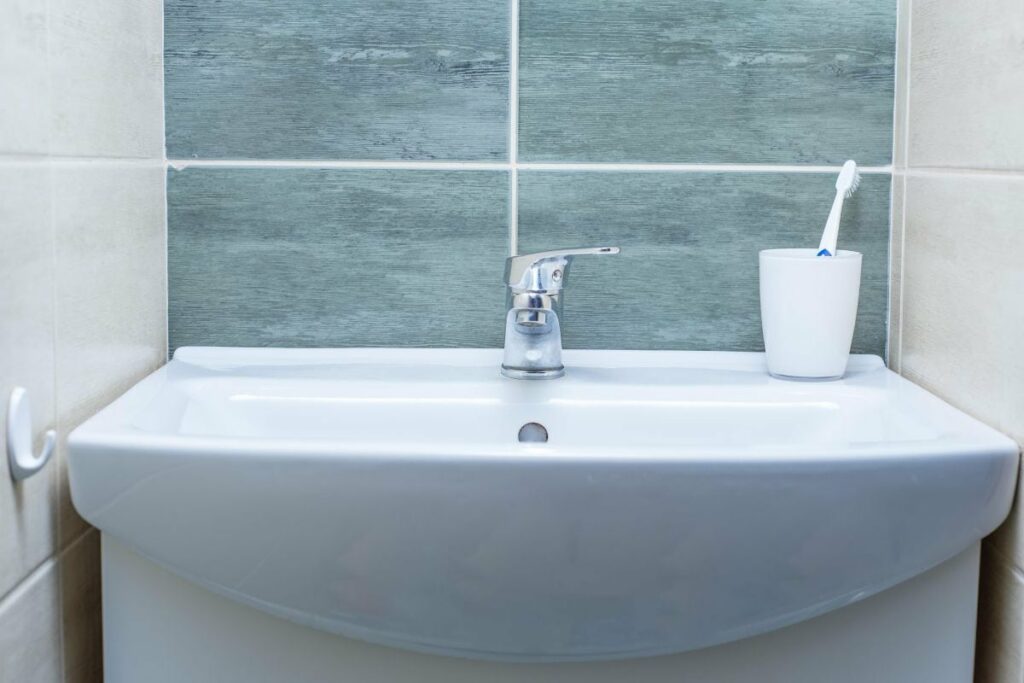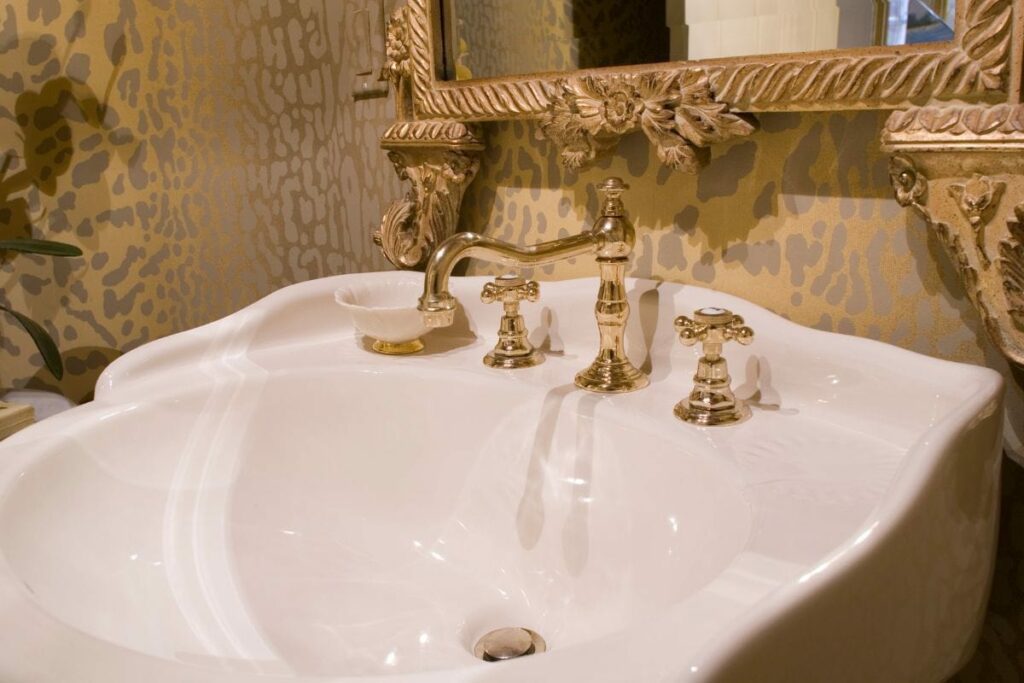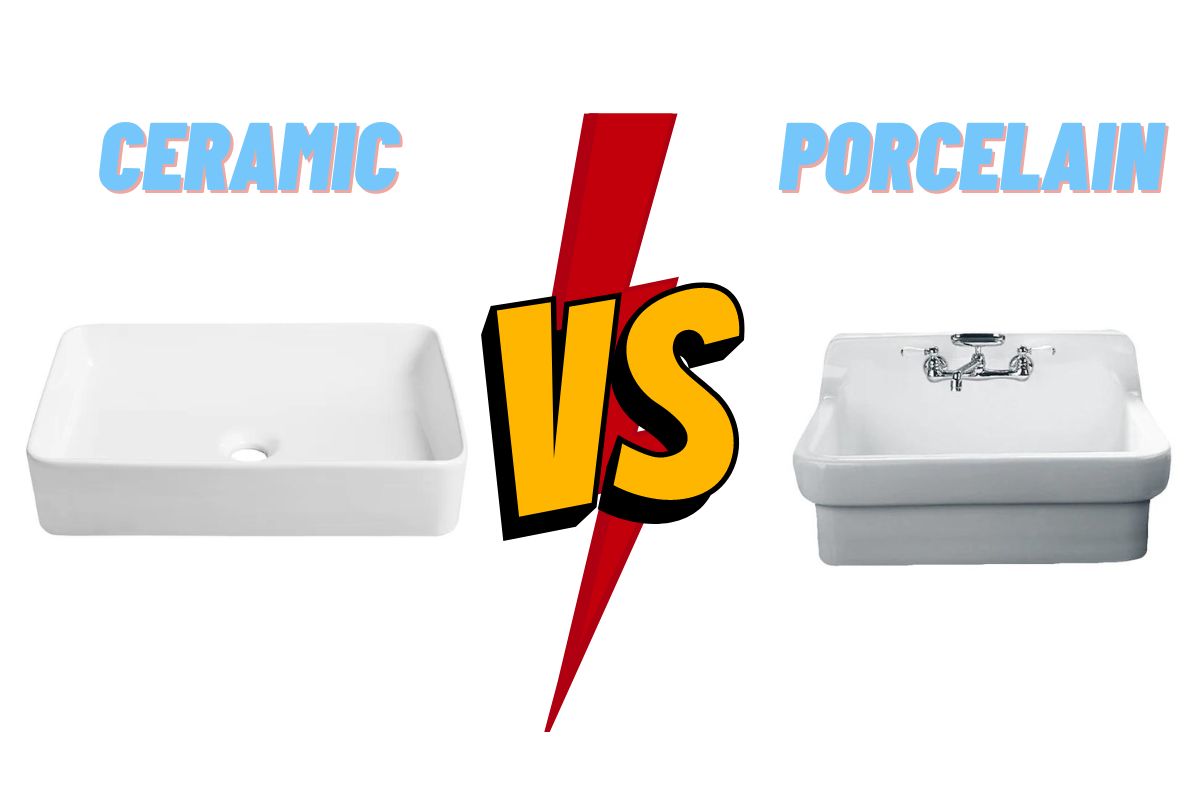Thinking of buying a new sink for your bathroom? Are you confused to choose between ceramic and porcelain? Well, here’s a guide that will help you decide.
Apparently, you cannot distinguish between porcelain and ceramic sink; they feel and appear the same. However, there is a slight difference in their chemical composition. The ceramic sink is made of clay powder and water, which is then heated and glazed. Whereas the porcelain sink is made of slightly fine clay heated at a very high temperature and may contain some heavy metal in between its layers.
This short answer may not be enough for you to decide, right? So, further, in this article, I will compare these two types of sinks in terms of durability, cost, color variations, installation, and maintenance. Then, you can decide which one’s best for your bathroom.
Ceramic Sinks

Ceramic is pottery, made from clay powder and water. Initially, the clay mixture is molded into different shapes, then it is baked in a kiln, where it loses water and gains strength. Since ceramic is porous, an enamel coating is done on it, to make it waterproof and shiny.
The final product is the sinks we see at various restrooms and kitchens. Ceramic sinks are usually white in appearance and are one of the most widely used sinks in the world. You may have one already installed in your house.
Porcelain Sinks

Porcelain is also a kind of ceramic material made from clay. However, it is made from fine and dense silicate-based clay called kaolin, sand, and felspar.
The clay-based mixture is molded into desired shaped and heated in a kiln up to a temperature of 2300 F. The heating drives out all the water content from the porcelain and makes it sturdy and strong. Porcelain, being made from finer and denser clay, is 30% stronger than ceramic. Moreover, it is nonporous which makes it waterproof.
Porcelain sinks, like ceramic ones, are white in color with a glossy appearance. You can use these sinks in your bathroom or kitchen space. They will surely make them look great!!
Porcelain vs. Ceramic Sink: Which is better?
Since I have explained the construction and composition of each material, let’s compare porcelain and ceramic toilets in terms of color, cost, weight, installation, porosity, and maintenance. These are the factors people are generally interested in when buying sinks.
1. Color
Ceramic and porcelain sinks are commonly available in white colors with a glossy appearance. They are also available in multiple other colors but you will have to search hard to find your desired color.
Moreover, ceramic sinks, being a popular choice, are available in a variety of styles and options. Whereas, porcelain sinks are usually simplistic.
2. Cost
Ceramic and Porcelain sinks are affordable and available at similar pricing. Some porcelain sinks are even cheaper than ceramic ones. You can easily buy a top-notch porcelain sink for a few hundred dollars.
Some premium quality ceramic sinks, based on design and looks, can be much more expensive than porcelain sinks.
3. Weight and Installation
Both types of sinks are quite heavy. However, porcelain sinks weights slightly more than ceramic sinks since porcelain sinks contain heavy gauge steel or cast iron that has been layered in the porcelain.
The weight makes the porcelain sinks installation more difficult. However, the drop-in sinks are still easy to install.
4. Durability
The manufacturing process of porcelain sinks makes them more durable and strong compared to ceramic sinks. They are made up of finer clay and baked at very high temperatures.
Ceramic sinks may not be more durable than porcelain ones. However, that doesn’t mean ceramic sinks aren’t good. They are scratch and chip-resistant. But will break when subjected to heavy impact.
5. Porosity
As I mentioned earlier that since ceramic is not made of very fine clay, during the manufacturing process pores are left in between. That’s why ceramic sinks are porous; an enamel coating is done on them to make them waterproof. However, over time, when that coating weakens water would enter the pores and makes it brittle. As a result, you will see cracks on the surface.
Porcelain, on the other hand, is non-porous. Being made from a fine dense mixture, it is less porous and doesn’t take in water at all. So, in terms of porosity, porcelain is a clear winner.
6. Mounting Options and Styles
A range of mounting options is available for ceramic sinks. Some common options are pedestal sinks, corner sinks, and under-mount sinks. Ceramic sinks are well-liked due to their sturdiness, wide range of design and color options, and overall aesthetic appeal.
About 90% of vanities have porcelain sinks. They come in different styles such as pron-front, and drop-in styles. Due to their susceptibility to crack when facing strong impact, they are not advised for kitchen sinks; however, they are perfect for vanities.
7. Maintenance
The ceramic surface is waterproof and incredibly smooth. Since there are no tiny gaps or fissures, dirt and filth cannot get inside. This explains why their maintenance is so easy.
You can simply wipe off the wet ceramic sink with a clean, dry towel to avoid stains. You can also use all sorts of cleaners and keep their original luster for a longer amount of time. However, if your sink bears some hand-painted designs, avoid using abrasive cleaners, as they may chip it off.
Unlike Ceramic Sinks, porcelain cleaners cannot be cleaned by abrasive chemicals. You can use a soap solution or gentle cleaner. Additionally, you must refrain from using very acidic cleaning solutions because they have the potential to gradually erode the porcelain’s surface.
The bottom line is both need the same amount of upkeep to maintain their longevity and shine. However, ceramic sinks need to be thoroughly cleaned frequently.
How To Tell if your Bathroom sink is Ceramic or Porcelain?
Since I have mentioned that technically there’s a difference between these two materials, people are interested in knowing how I can distinguish between these two types of sinks.
They are very similar; it hard to Tell
Many people confuse porcelain with ceramic sinks, and some even think both of them are the same material with different names. That’s because you cannot differentiate between the two by just looking at them; they both have a glossy white surface and a smooth surface. No amateur can distinguish between them by just looking at them.
Examine the Chipped
If the sink is chipped in some place, examine the color. If the color is tan, then that will be a ceramic sink. Most porcelain sinks are not glazed, they have a consistent color inside and out,
Check its Product No, on the Internet
The best way is to check the serial number of your product and search for it on the internet. It will take you to the manufacturer’s website and you will surely find all the details of the product and then figure out its type.
Final Words
If you are looking for something appealing and classy, you may find some pretty good designs in ceramic sinks. The porcelain sinks may be simplistic in nature. However, in terms of durability and quality, they are superior to ceramic sinks.

Amos Christen graduated with a bachelor’s degree in Interior Design from Drexel University — Philadelphia, PA. Since 2003, Amos has worked with top interior design professionals in this area, including architects and interior/graphic/lighting designers. As a skilled interior designer, Amos Christen is highly versed in fine arts and crafts and uses that to supplement his main area of expertise. He often publishes articles related to home décor on several websites, including Sprucetoilets.com, Sprucebathroom.com, and Mybesuitedhome.com. He also contributes to leading interior design magazines.
